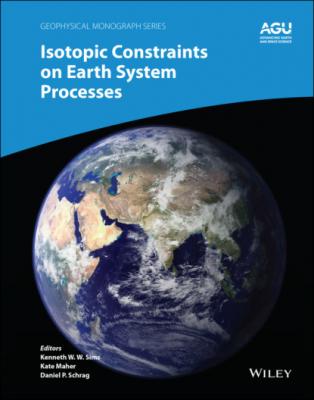Isotopic Constraints on Earth System Processes. Группа авторов
Чтение книги онлайн.
Читать онлайн книгу Isotopic Constraints on Earth System Processes - Группа авторов страница 18
 alt="upper D Subscript upper C a upper O left-parenthesis upper S i upper O 2 right-parenthesis Superscript upper E"/> ) while that for 44CaO was reduced by a factor
alt="upper D Subscript upper C a upper O left-parenthesis upper S i upper O 2 right-parenthesis Superscript upper E"/> ) while that for 44CaO was reduced by a factor The solid black line in Fig. 1.4 shows the calcium isotopic fractionation calculated using solutions to equations 1.7 for 44CaO, and 40CaO, and
Figure 1.4 Figure taken from Richter et al. (2003) showing the δ44Ca of slabs cut perpendicular to the long axis of glass recovered from rhyolite‐basalt diffusion couples RB‐2 and RB‐3. A normalized distance scale with units x/t 1/2 , where x is in microns and t is the run duration in hours is used in order that the data from the two experiments of different size and duration can be plotted along the same normalized distance axis. The thin horizontal line shows the initial 44C/40Ca of the rhyolite and basalt relative that of a CaCO3 salt standard. The thicker black line is the result of a model calculation with the mass‐dependence of the diffusion coefficient of calcium calculated as
1.3.2. Isotope Fractionation between Melts from a Natural Setting
The relevance to geology of the kinetic isotope fractionations by diffusion in melts as documented by the laboratory experiments depends on whether similar fractionations can be found in natural settings. Chopra et al. (2012) addressed this in a detailed study, in which the magnesium isotopic fractionations in diffusion couples juxtaposing felsic and mafic powdered rock samples from the Vinalhaven intrusive complex in Maine were compared with the isotopic fractionations they measured across an exposed contact between these two rock types. Fig. 1.5 shows the piston cylinder assembly used by Chopra et al. (2012) for the experiments along with a backscattered electron image of glass recovered from their experiment GBM‐2. The figure also shows the temperatures measured in the piston cylinder assembly above and below the sample and a temperature profile extrapolated the measured temperatures into the sample while it was at run conditions. The temperatures in the piston cylinder assembly were determined by the thickness of spinel that grew where Al2O3 and MgO were in contact at various places in the assembly based on a calibration of the growth rate of spinel as a function of temperature and pressure by Watson et al. (2002). The calibration is used to convert the spinel thickness into the time‐averaged temperature over the duration of the experiment.
Fig. 1.6 shows the results of experiment GBM‐2 from Chopra et al. (2012) in which melt derived from rock powers made from the mafic and felsic rocks of the Vinalhaven igneous complex were juxtaposed in a piston cylinder assembly, shown schematically in Fig. 1.5. The temperature differences across the experimental sample turned out to be important for distinguishing between that part of the isotopic fractionation due to chemical diffusion versus that due to thermal diffusion. Fig. 1.6 also shows the weight % MgO and magnesium isotopic fractionation measure in rock powders that were drilled at spots across an exposed contact between the felsic and mafic rocks at Vinalhaven. The MgO data on the felsic side of the contact shows quite a bit of scatter due to the powders being mixtures of different proportions of relatively coarse‐grained minerals with different MgO content. The isotopic fractionation data are less scattered reflecting negligible isotopic fractionation between the minerals at magmatic temperatures. The weight percent MgO and the isotopic fractionation across the glass recovered from the piston cylinder experiment GBM‐2 was fit with model profiles from a diffusion calculation done in much the same way as for calcium in Section 1.3.1, with